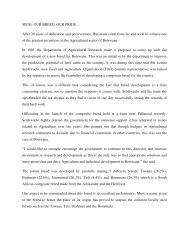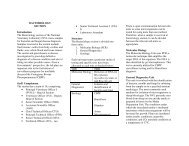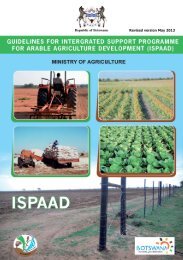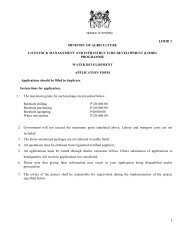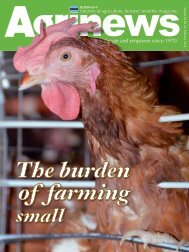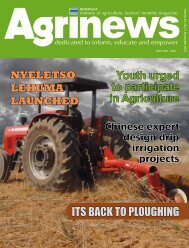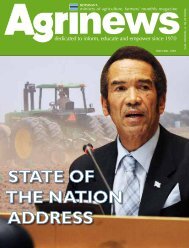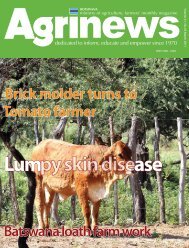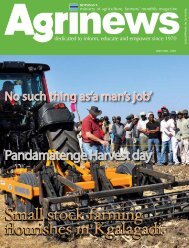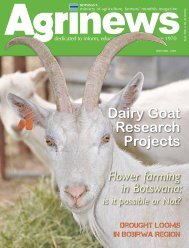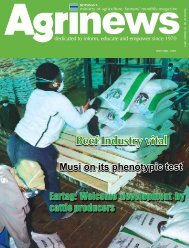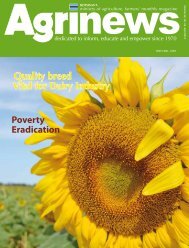Agrinews January 2013 - Ministry of Agriculture
Agrinews January 2013 - Ministry of Agriculture
Agrinews January 2013 - Ministry of Agriculture
Create successful ePaper yourself
Turn your PDF publications into a flip-book with our unique Google optimized e-Paper software.
BAMBARA GROUNDNUT<br />
Background Information<br />
Bambara groundnut is an indigenous legume <strong>of</strong> Africa<br />
which originated from the Sahelian region <strong>of</strong> present day<br />
West Africa. Through migration, people brought the crop<br />
to southern Africa many years ago. In Botswana, Bambara<br />
groundnut is known as jugobean or ditloo. It is related to<br />
cowpea. Thus, botanically it is called Vigna subterranean<br />
(L.) Verdc. In Botswana, it is found in various landraces<br />
and farmers grow it in mixed/intercropped/sole cropped<br />
systems mainly for consumption and sale. On average,<br />
farmers get yields <strong>of</strong> about 200 kg/ha. In 2008, the two<br />
most promising varieties namely Keledi (MA -15A) and<br />
Mokgalo (N-100) were released.<br />
Plant Characteristics<br />
Bambara groundnut is a herbaceous annual legume with<br />
compact well-developed tap root with many short lateral<br />
stems on which the leaves are borne. The released varieties<br />
are bunchy type and are self-pollinated. The crop forms<br />
pods below the soil surface or just above the ground<br />
and majority contain one seed. The pod colours <strong>of</strong> the<br />
released varieties are creamish for Keledi and purplish for<br />
Mokgalo. Seed colours are cream with a v-shaped purple<br />
colour surrounding a white eye for Keledi and completely<br />
purple with a white eye for Mokgalo<br />
Growth and Development<br />
Seed germination takes 7-15 days. Flowering starts 30 to<br />
45 days after sowing and may continue until the plant<br />
matures. Pod and seed development take place about<br />
30 to 40 days after fertilization. Maturity varies with<br />
landraces and seasons and may go up to 180 days. The<br />
released varieties mature between 130-150 days<br />
Mokgalo tend to flower, pod and mature earlier than<br />
Keledi. The crop is a typical short-day plant, that is, long<br />
days may delay/prevent flowering and podding.<br />
Soil and Fertilizer Requirements<br />
The crop is adapted to a wide range <strong>of</strong> soils, but<br />
welldrained soils, sandy loams with pH <strong>of</strong> 5.0-6.5., soils<br />
rich in phosphorus and potassium are most suitable.<br />
Yield potential is reduced when grown in sandy clay<br />
loams,. It performs well in poor soils with low nutrients.<br />
But in soils with abundant nitrogen, the crop grows<br />
vegetatively while in calcareous soils, it grows poorly.<br />
Chemical fertilizer recommendations in Botswana are<br />
lacking because the crop does not give significant<br />
responses.<br />
Climatic Requirements<br />
Bambara groundnut requires warm temperatures <strong>of</strong> 20<br />
to 280C and does not tolerate freezing temperatures at<br />
any stage <strong>of</strong> growth. It is most suited for hot dry areas<br />
and thrives well in marginal rainfall conditions too dry<br />
for sorghum, maize and groundnut. However, for better<br />
performance, the crop requires an average rainfall <strong>of</strong><br />
about 600 to 700mm during the growing period. Too<br />
much rain at harvest time may result in yield losses.<br />
Planting<br />
Plant seeds in a deeply ploughed field with a fine seedbed.<br />
Planting should be done around October/ November<br />
after good rains. The seed rate for the released varieties<br />
is 50 kg/ha but can vary with seed size and according to<br />
literature it varies for small or big seeds from 25-75 kg/<br />
ha. Seeds for planting should be treated with fungicide<br />
and planted at a depth <strong>of</strong> 2.5-3.0 cm in heavy soils and<br />
5.0 – 7.5 cm in sandy soils. Hand hoe or planters with<br />
correct plates can be used to plant seeds. Recommended<br />
spacing for the released varieties is 75 cm inter-rows by<br />
20 cm within rows in order to get 67,000 plants/ha.<br />
Yields and Nutrition<br />
Yields depend on variety and environmental conditions.<br />
Recommended variety yields ranged from 0.1-3.6 t/ha<br />
under rain fed. But elsewhere under irrigation, a yield <strong>of</strong><br />
4.2 t/ha, has been reported. Mokgalo tend to out yield<br />
Keledi when they are grown under similar conditions.<br />
Seeds are nutritious and provide a balanced diet.<br />
They contain sufficient quantities <strong>of</strong> protein (16-25%),<br />
carbohydrates (50-69%), oil (6-12%) and minerals such as<br />
calcium, potassium, phosphorus, magnesium, iron and<br />
sodium. Haulm can be used to feed livestock. Due to its<br />
ability to fix nitrogen, Bambara groundnut is useful in crop<br />
rotation.<br />
The Director Department <strong>of</strong> Agricultural Research Private Bag 0033, Gaborone. Phone: 267-366-8100 Fax: 267-3928965<br />
Designed by M. Modipe MoA graphix



